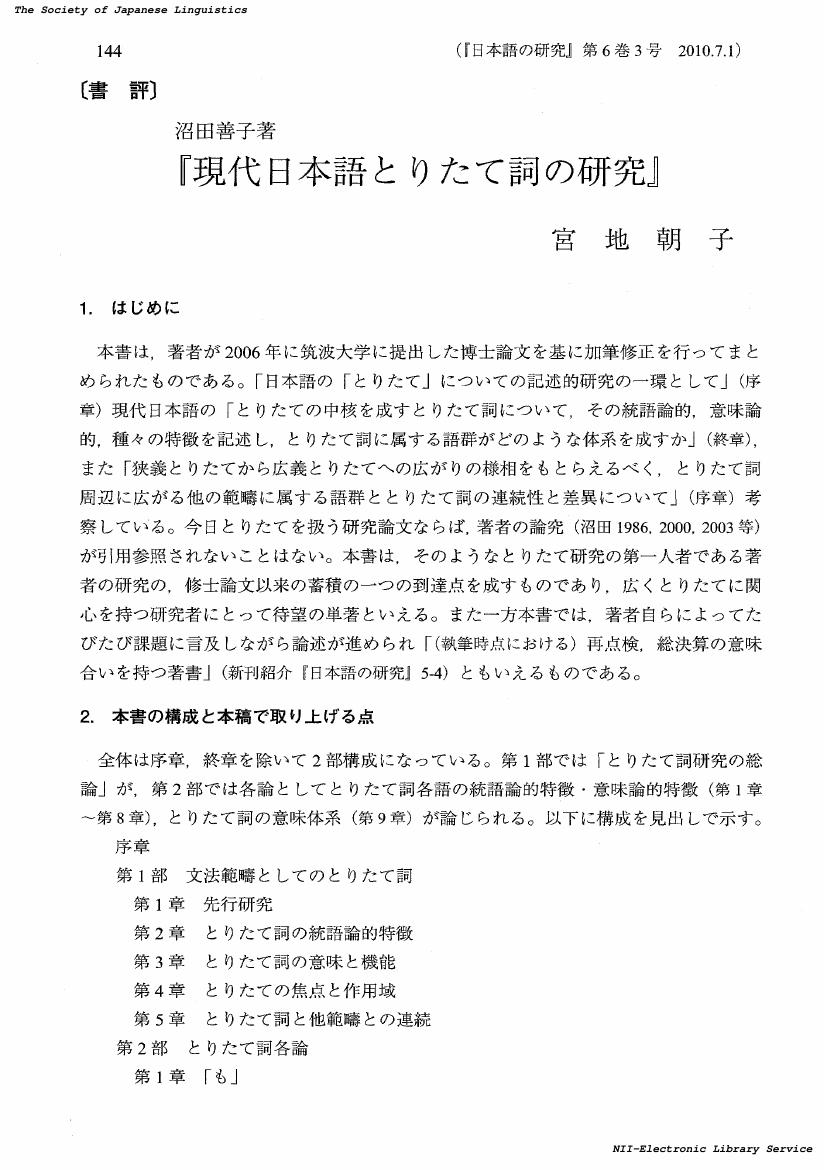3 0 0 0 OA 副助詞研究の軌跡と課題
- 著者
- 宮地 朝子 MIYACHI Asako
- 出版者
- 名古屋大学人文学研究科
- 雑誌
- 名古屋大学人文学研究論集 (ISSN:2433233X)
- 巻号頁・発行日
- vol.2, pp.43-63, 2019-03-31
This paper gives an overview of past studies on Japanese adverbial particles, known as fuku-joshi, and shows the prospects for future tasks. An “adverb” is an adverbial particle which functions as the main structure of a continuous/predicative modifier phrase. However, it also shows various usage which overlaps with case particles, focus/topic particles, kakari-joshi, and even suffixes. Furthermore, each individual word classified as an adverbial particle has changed historically. This is why diverse positions have been forested in the research of “adverbial particles,” as well as various provisions being made with different objects and scopes of observation. In the background, the difference between researchers’ interests in modern and classical languages is also greatly involved. Moreover, the difference in the fundamental view on category setting is also an influence; for example, it influences where to place the main evidence (functional meaning or syntactic behavior), and how to see the relationship between the form and its affiliation category (whether different categories are set for each function, or whether multiple functions within the category are accepted). On the other hand, many of the adverbial particles are multifunctional over time. It can be said that pursuing a consistent explanation for its dynamics and diversity leads to a reasonable answer to the problem of understanding adverbial particles.
2 0 0 0 比較・程度・限定を表す日本語助詞の其他否定用法獲得に関する研究
本研究課題は、日本語構文構造史の一として、形式名詞・格助詞・副助詞として言語化される意味機能(比較・程度・限定)と、係助詞として体現する意味機能(其他否定)の関わり、当該の意味機能にかかる文法化を可能にする言語内・外的条件を考察するものである。最終年度は形式名詞の文法化という観点からの歴史的・理論的考察を中心に行った。まず前年度のシンポジウムの成果を論文化し、形式名詞の比較・程度から限定のとりたて助詞へ、あるいはモダリティの助動詞へといった文法機能への用法拡大を考えるためには、名詞句としての特性からの分析が必要かつ有効であることを主張し、係助詞化には否定のスコープの再解釈が要因となるという説を支持した(青木編『日本語の構造変化と文法化』所収論文)。ここには形式名詞による範疇化という操作そのものの意味的文法的特性を追究する必要性の主張も含む。これに基づく具体的実践として、モダリティの助動詞へ対象を広げ、口頭発表「筈からハズへ、訳からワケへ-名詞が文法化するとき」(名古屋大学文学研究科シンポジウム「拡張し変容する日本語」H19.3.3)を行った。ここでは名詞述語文および日本語の名詞の指示の文脈依存性という普遍の構造的前提と、名詞ハズ・ワケの形式化、個別具体から一般抽象へという語用論的再解釈が「助動詞」的用法の獲得につながっていると主張した。また今年度は本研究課題を含む10年来の研究成果として『日本語助詞シカの構文構造史的研究』を上梓した。ここまでに得られた成果と視点・試みの精緻化・発展を目的とし今後は「名詞の文法化」という包括的な新課題に着手する。形式名詞の文法機能への体系的な参画は、古代語と近現代語の顕著な相違である。この発展的課題への着手は、動態としての日本語構文構造の追究という根本的な問題へのアプローチとなるだろう。本研究課題から発した大きな成果と位置づける。
- 著者
- 宮地 朝子
- 出版者
- 日本語学会
- 雑誌
- 日本語の研究 (ISSN:13495119)
- 巻号頁・発行日
- vol.6, no.3, pp.144-150, 2010-07-01 (Released:2017-07-28)
名詞述語文は,一般に「aとbは同一である」または「aはAに包摂される」という関係をあらわす(例:「平塚らいてうは {『青鞜』の創刊者 / 作家} だ」)が,その一方で,「ユミはウナギだ (= ユミはウナギを注文した,ユミはウナギの専門家だ,等)」「ヒロシはスーツだった (= ヒロシはスーツを着ていた)」「ナオミは東京に行く予定だ (= ナオミには東京に行く予定がある)」といった,非典型的な意味を持つ有標的な名詞述語文も存在する。本研究では,このような有標的名詞述語文の分類と,形式意味論,歴史言語学,対照言語学,語彙論といった諸観点からの分析に取り組む。
1 0 0 0 IR 副助詞研究の軌跡と課題
- 著者
- 宮地 朝子 MIYACHI Asako
- 出版者
- 名古屋大学人文学研究科
- 雑誌
- 名古屋大学人文学研究論集 = The journal of humanities, Nagoya University (ISSN:2433233X)
- 巻号頁・発行日
- no.2, pp.43-63, 2019
本稿の一部は、科学研究費補助金15K02563による研究成果を含む。
1 0 0 0 OA 「ほか」の諸用法と名詞句の多様性
- 著者
- 宮地 朝子
- 出版者
- 名古屋大学文学部
- 雑誌
- 名古屋大学文学部研究論集 (ISSN:04694716)
- 巻号頁・発行日
- vol.56, pp.1-18, 2010-03-31 (Released:2010-05-21)
This paper examines the syntactic and semantic characteristics of one of the Japanese particles that derived from noun called “hoka”. This particle has various historical and dialectal usages. The usages of the particle “hoka” is comprised of six categories as (1) Outside/different location, (2) The other thing or people (something else/somebody else), (3) A location other than the described location (indefinite), (4) a: Exceptional phrase in the form of “x yori-hoka-ni・・・NEG”, (4) b: Exceptional phrase in the form of “x yori-hoka・・・NEG”, (5) Additional phrase in the form of “x yori-hoka,” (6) Focus particle as Negative Polarity Item. The above mentioned first five categories show syntactic characteristics while the categories of 3, 4, and 5 can be explained as formal nouns. In contrast the type (6) can be explained as particle NPI because of reanalysis in non-existential sentence. Usage of the article “hoka” in semantic functions of noun phrase has some differences depending on its grammatical position in a sentence. We can consider the usages of categories No 1 and 2 as Referential Noun; No 3, 4, and 5 as Non-referential Noun Phrase. Furthermore, the category No 3 can be described as predicate nominal; No 4 as Quantified Noun Phrases; and No 5 as Noun Phrases Involving a Variable (NPIV) (Nishiyama 2003). In conclusion various usage of the particle “hoka” can be explained by diversity of nominal and its syntactic position.
1 0 0 0 OA 日本語助詞シカに関わる構文構造史的研究 : 文法史構築の一試論
- 著者
- 宮地 朝子 Miyachi Asako
- 巻号頁・発行日
- 2001-03-26 (Released:2006-05-25)
名古屋大学博士学位論文 学位の種類:博士(文学) (課程) 学位授与年月日:平成13年3月26日
